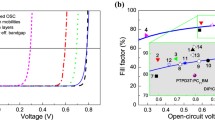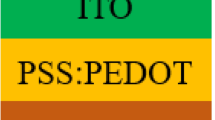Abstract
The higher efficiencies of organic solar cells (OSCs) are critical for improving the stability and reliability of diverse operating states by performing a drift–diffusion approach. This concern has explored the effect of parasitic resistances in the optimised OSC measured under intense light and dark illumination. The significant interpretations of temperature and light intensity dependency on photovoltaic (PV) parameters including the open-circuit voltage (VOC), short-circuit current density (JSC), fill-factor (FF) and the overall power conversion efficiency (PCE) have been investigated systematically. The numerical approach also revealed that the variance in the bandgap (Eg) along with the trap density (Nt) of the P3HT:PC61BM absorber is a major contributor to deviations in JSC and VOC. The designed OSC demonstrates the appropriate parasitic components comprised of series resistance (RS of 1 Ω cm2) and shunt resistance (RSH of 103 Ω cm2), which appears to be one of the optimal strategies to achieve an excellent PCE of 8.15%. This approach will serve as a combined roadmap for revealing the necessity of the full potential of the absorber material on the performance of OSC structures shortly.








Similar content being viewed by others
References
C Wöpke et al, Nat. Commun. 13, 3786 (2022)
Y Zhang et al, Nano Energy 93, 106858 (2022)
G Perrier et al, Sol. Energy Mater. Sol. 101, 210 (2012)
Y Gao et al, Adv. Mater. Int. 2, 1400555 (2015)
R C I MacKenzie et al, J. Chem. Phys. 132, 064904 (2010)
H Mäckel et al, Phys. Rev. Appl. 9, 034020 (2018)
R C I MacKenzie et al, Adv. Energy Mater. 6, 1501742 (2016)
B Philippa et al, Sci. Rep. 4, 1 (2014)
W R Erwin et al, J. Phys. Chem. C 122, 7859 (2018)
R C I MacKenzie et al, Adv. Energy Mater. 2, 662 (2012)
J H Kim et al, Electron. Mater. Lett. 12, 383 (2016)
T Kirchartz et al, J. Phys. Chem. C 116, 7672 (2012)
D Gogoi et al, Optic. Mater. 143, 114238 (2023)
R Dattani et al, J. Mater. Chem. A 2, 14711 (2014)
B Arredondo et al, Sol. Energy 232, 120 (2022)
F Deschler et al, Phys. Chem. Chem. Phys. 15, 764 (2013)
M N Zidan et al, Mater. Res. Express 8, 095508 (2021)
L Zhu et al, Nat. Mater. 21, 656 (2022)
M Abdallaoui et al, Opt. Mater. 105, 109916 (2020)
S Bhattarai et al, IEEE Trans. Electron Devices 69, 3217 (2022)
E Li et al, Chem. Phys. Lett. 553, 36 (2012)
D A Palacios-Gómez et al, ACS Appl. Energy Mater. 4, 10867 (2021)
B Kadem et al, Optik 204, 164153 (2020)
D A Vithanage et al, Nat. Commun. 4, 2334 (2013)
H K H Lee et al, Sol. RRL 3, 1800207 (2019)
S Solak et al, Solar RRL 5, 2100787 (2021)
Z Kan et al, J. Mater. Chem. A 4, 1195 (2016)
J A Röhr et al, J. Appl. Phys. 128, 165701 (2020)
B Qi et al, Phys. Chem. Chem. Phys. 15, 8972 (2013)
D Gogoi et al, Phys. Scr. 98, 085908 (2023)
S Sen et al, Braz. J. Phys. 51, 1661 (2021)
C Wang et al, J. Mater. Chem. A 5, 3995 (2017)
B Xiao et al, Phys. Rev. Appl. 14, 024034 (2020)
R Hanfland et al, Appl. Phys. Lett. 103, 063904 (2013)
R C I MacKenzie et al, J. Phys. Chem. C 115, 9806 (2011)
M M Voigt et al, Sol. Energy Mater. Sol. Cells 95, 731 (2011)
F Padinger et al, Adv. Fun. Mater. 13, 85 (2003)
P Kumar et al, J. Appl. Phys. 105, 104507 (2009)
T Stubhan et al, Org. Electron. 12, 1539 (2011)
O Urper et al, Mater. Lett. 258, 126641 (2020)
E A J Abadi et al, Mater. Today Energy 25, 100969 (2022)
M Piralaee et al, Optik 251, 168453 (2022)
C R Kishore et al, Bull. Mater. Sc. 45, 1 (2022)
P Li et al, Optik 265, 169488 (2022)
F Lmai et al, Optik 262, 169295 (2022)
L Reshma et al, Org. Electron. 47, 35 (2017)
C P Li et al, Org. Electron. 108, 106602 (2022)
K Hussain et al, Sol. Energy 243, 193 (2022)
A Vázquez et al, Opt. Mater. 132, 112852 (2022)
U F Ghumman et al, Comput. Mater. Sci. 211, 111491 (2022)
F Kaka et al, Sol. Energy 231, 447 (2022)
N Barth et al, Sol. Energy Mater. Sol. 148, 87 (2016)
S Chander et al, Energy Rep. 1, 104 (2015)
Acknowledgements
The authors are pleased to express gratitude to Roderick C I MacKenzie at Durham University for developing GPVDM software and making it freely available. The author Dipankar Gogoi wishes to express his deepest gratitude to NIT Arunachal Pradesh, Jote, India for supporting this research on organic solar cells.
Author information
Authors and Affiliations
Corresponding author
Rights and permissions
About this article
Cite this article
Gogoi, D., Bhattarai, S. & Das, T.D. Influence of altered parasitic aspects on the device structure for efficient organic solar cells. Pramana - J Phys 97, 188 (2023). https://doi.org/10.1007/s12043-023-02660-8
Received:
Revised:
Accepted:
Published:
DOI: https://doi.org/10.1007/s12043-023-02660-8




